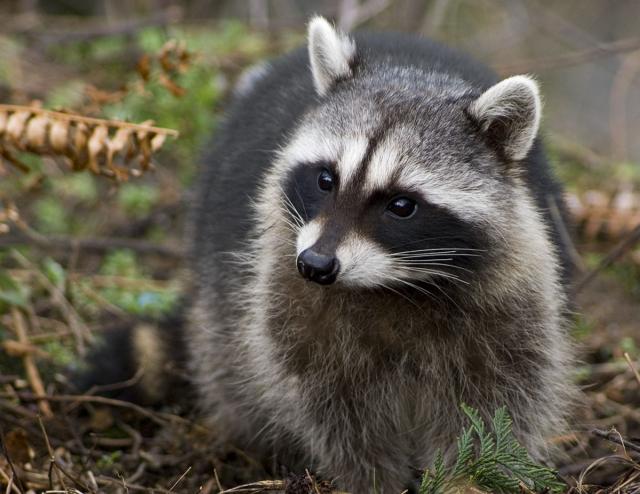Raccoon (Procyon lotor) Taxonomic classification: • Kingdom: Animalia • Phylum: Chordata • Subphylum: Vertebrata • Class: Mammalia • Subclass: Theria • Subclass-tine: Eutheria • Old Order: Euarchontoglires • Order: Carnivora • Family: Procyonidae • Gender: Procyon • Race: Procyon lotor • Subraces: P. l. auspicatus - P. l. elucus - P. l. excelsus - P. l. fuscipes - †P. l. gloveralleni - P. l. grinnelli - P. l. hernandezii - P. l. hirtus -P. l. incautus - P. l. inesperatus - P. l. insularis - P. l. litoreus - P. l. lotor - P. l. marinus - P. l. maynardi - P. l. megalodous - P. l. pacificus -P. l. pallidus - P. l. psora - P. l. pumilus - P. l. simus - P. l. vancouverensis
1. Distribution and habitat:
The raccoon was originally home to North and Central America, southern Canada, Mexico and the United States occur in regions near the water, or wherever people live. Because the fur in Europeand Asia have opened racoon-farms, and adapting to local conditions escaped specimens proliferated. Expansion of the center of Europe, West Germany (Mosel Valleyand the Eifel Mountains), the Benelux countries and the easternregion of France, and the former Soviet Union. 20 century in Hungary were published. In 1934, Hermann Goering, who was then the head of the Reich Forestry Office, was given permission to some of the Germanforest mosómedvepárt free to let me go "reach the fauna of the Empire."
Widespread, lack of significant natural enemies. Where it appears to cause havoc among the birds whose eggs are kidnapped. The bushes and trees near shore areas like where most nights you move. Skillfully climb trees and can swim well.
2. Morphology, structure:
The raccoons usually 50−70 cm long, 20−25 cm tail, shoulder height20-30 cm. 6-7 kilograms of weight, but this can vary between 2−12kg. A large part of the mass of stored fat, especially for animalsliving in colder climates. The sexes are identical, although the males are slightly larger. Gray-brown fur, white on the abdomen. The characteristic black and white ringed tail stripes, and black mask over the eyes, whichsort of gives the appearance of miniature villain often really cheekySteals animal. Vulpine shape of the head anyway, pointed noseand ears, paws ötujjú very clever. Strong claws to climb treesskillfully can - in case of danger in the air would rather flee. A littlewhile on their mother's protective gaze, whereas skillfully learn to balance and climb.
3. Nutrition:
Omnivorous, plants, small animals, both consuming and is oftenseen as a shallow water fishing. Generally, plant seeds and fruitsconsumed (eg, acorns, berries, fruit, etc), sometimes also rájáragriculture crops (peach, watermelon, plums, citrus fruits, cereal, sometimes). Where animal food consumption, including menu ofarthropods, fish, rodents, amphibians, and eggs are included. Theproximity of people is exploited: usually searching the trash,sometimes kiborítva the containers to a variety of food residuesand other discarded after you. A rich tápláléklelőhelyen can collectmore specimens. The food handy front paws and hold it in his mouth.
4. Customs and reproduction:
The raccoon is active mainly at night, a solitary species. The living room is usually filled the trees curled up safe canopy (Being an excellent climber) or during rocks. In addition, large fall scan tolerate. Although rarely enough to go into the water, an excellent swimmer, and although the soils are slowly moves ,amazingly fast, up to 25 km/h speed can run. Excellent hearing, eyesight night nor let you down. A copy is usually a 1−3 km-diameter area moves, which may overlap with other zones are also individuals. The only food is scarce, the areas characterized by territoriality. Males usually have larger area that the females. Winter is not winter sleep dream, cooler regions, although a longer period of inactivity can be observed. Because the vital signs are not slowing down, the animal use its own fat.. Fall lose weight up to half a winter. The breeding season from February to June, males often extended their territories to meet with several females. In this case, even for a while, the couple can remain together, but their paths are separated after mating. The gestation lasts 63−65 days. Farrow normally once a year, mostly in hollow trees hole, during rocks, buildings, gives birth to 3−7, usually 4 blind kid. The pup's eyes just about. opens at the age of three weeks, separated by approx. Occurs after 10 weeks. Subsequently, the feeding of young animals have been kept with their mothers on the roads. Solitary animals, but in many cases, the sire of the family for longer stays, while the offspring are small. Small Raccoons spend the first winter with their mother, and the following spring, leaving the parental nest, often settled in fairly close. Females have one, while the males become sexually mature at the age of two.
5. Protection, role in the ecosystem
Raccoon was established in East Germany in 1945 when 25 raccoons escaped from a fur farm at Wolfshagen east of Berlin after an air strike. he estimated number of raccoons was 285 animals in the Hessian region in 1956, over 20,000 animals in the Hessian region in 1970 and between 200,000 and 400,000 animals in the whole of Germany in 2008.
To date, it bred for its fur. Several attempts have been made in the domestication of species, but not really suitable for pet as prone to cause damage to the environment. This can cause serious damage to farmers when damage their fields and orchards.
There are many diseases − such as rabies and plague − may be carriers, which are dangerous for humans and animals alike.
The species belongs to not endangered category (LC IUCN - Least Concern).
6. Relation to the soil
The raccoon in the hearing threshold from 50 to 85 kHz ranges, whether in the underground movement of earthworms are able to hear it. No significant effect on the soil, but significant memebre of the terrestrial ecosystem.
http://en.wikipedia.org/wiki/Raccoon
http://hu.wikipedia.org/wiki/Mos%C3%B3medve
http://www.veszpzoo.hu/mosomedve.php
http://www.iucnredlist.org/apps/redlist/details/41686/0
